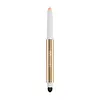What's inside
What's inside
 Key Ingredients
Key Ingredients

 Benefits
Benefits

 Concerns
Concerns

 Ingredients Side-by-side
Ingredients Side-by-side

Caprylic/Capric Triglyceride
MaskingIsononyl Isononanoate
EmollientIsododecane
EmollientOctyldodecanol
EmollientHydrogenated Polydecene
EmollientKaolin
AbrasivePolyethylene
AbrasiveSynthetic Fluorphlogopite
Hydrogenated Microcrystalline Wax
Emulsion StabilisingSynthetic Wax
AbrasiveEuphorbia Cerifera Wax
Trimethylsiloxysilicate
EmollientGlyceryl Behenate/Eicosadioate
EmollientBisabolol
MaskingTocopheryl Acetate
AntioxidantSodium Hyaluronate
HumectantGlucomannan
Skin ConditioningDisteardimonium Hectorite
StabilisingPropylene Carbonate
SolventC24-28 Alkyl Methicone
EmollientEthylhexyl Palmitate
EmollientTin Oxide
AbrasiveTrihydroxystearin
Skin ConditioningBenzoic Acid
MaskingTocopherol
AntioxidantCI 77891
Cosmetic ColorantIron Oxides
CI 77491
Cosmetic ColorantCI 77492
Cosmetic ColorantCI 77499
Cosmetic ColorantMica
Cosmetic ColorantCaprylic/Capric Triglyceride, Isononyl Isononanoate, Isododecane, Octyldodecanol, Hydrogenated Polydecene, Kaolin, Polyethylene, Synthetic Fluorphlogopite, Hydrogenated Microcrystalline Wax, Synthetic Wax, Euphorbia Cerifera Wax, Trimethylsiloxysilicate, Glyceryl Behenate/Eicosadioate, Bisabolol, Tocopheryl Acetate, Sodium Hyaluronate, Glucomannan, Disteardimonium Hectorite, Propylene Carbonate, C24-28 Alkyl Methicone, Ethylhexyl Palmitate, Tin Oxide, Trihydroxystearin, Benzoic Acid, Tocopherol, CI 77891, Iron Oxides, CI 77491, CI 77492, CI 77499, Mica
Water
Skin ConditioningCoco-Caprylate/Caprate
EmollientHydrogenated Polyisobutene
EmollientSorbitan Isostearate
EmulsifyingGlycerin
HumectantPropanediol
SolventPropylene Glycol
HumectantSynthetic Fluorphlogopite
Alumina
AbrasivePhenoxyethanol
PreservativeMagnesium Sulfate
Disodium Stearoyl Glutamate
CleansingParaffin
PerfumingHydroxyacetophenone
AntioxidantDisteardimonium Hectorite
StabilisingCera Microcristallina
Emulsion StabilisingCaprylyl Glycol
EmollientSilica Silylate
EmollientSynthetic Wax
AbrasiveCaffeine
Skin ConditioningTrisodium Ethylenediamine Disuccinate
Aluminum Hydroxide
EmollientTocopherol
AntioxidantTin Oxide
AbrasiveHelianthus Annuus Seed Oil
EmollientCI 77891
Cosmetic ColorantCI 77491
Cosmetic ColorantCI 77492
Cosmetic ColorantCI 77499
Cosmetic ColorantWater, Coco-Caprylate/Caprate, Hydrogenated Polyisobutene, Sorbitan Isostearate, Glycerin, Propanediol, Propylene Glycol, Synthetic Fluorphlogopite, Alumina, Phenoxyethanol, Magnesium Sulfate, Disodium Stearoyl Glutamate, Paraffin, Hydroxyacetophenone, Disteardimonium Hectorite, Cera Microcristallina, Caprylyl Glycol, Silica Silylate, Synthetic Wax, Caffeine, Trisodium Ethylenediamine Disuccinate, Aluminum Hydroxide, Tocopherol, Tin Oxide, Helianthus Annuus Seed Oil, CI 77891, CI 77491, CI 77492, CI 77499
 Reviews
Reviews

Ingredients Explained
These ingredients are found in both products.
Ingredients higher up in an ingredient list are typically present in a larger amount.
Ci 77491 is also hydrated iron III oxide. It's sole purpose is to give a red/pink hue to products.
Iron III oxides are classified as inorganic chemicals for coloring.
Synthetically created Ci 77491 is considered safer than those naturally found. This is because the synthetically created version may contain less impurities. Iron oxides are generally non-toxic and non-allergenic.
Learn more about CI 77491Ci 77492 is also hydrated iron III oxide. It's sole purpose is to give a yellow hue to products.
Iron III oxides are classified as inorganic chemicals for coloring.
Synthetically created Ci 77492 is considered safer than those naturally found. This is because the synthetically created version may contain less impurities. Iron oxides are generally non-toxic and non-allergenic.
Learn more about CI 77492Ci 77499 is also hydrated iron III oxide. It is created from mixing red and black iron oxides. This helps give shades of darkness to a product.
Iron III oxides are classified as inorganic chemicals for coloring.
Ci 77891 is a white pigment from Titanium dioxide. It is naturally found in minerals such as rutile and ilmenite.
It's main function is to add a white color to cosmetics. It can also be mixed with other colors to create different shades.
Ci 77891 is commonly found in sunscreens due to its ability to block UV rays.
Learn more about CI 77891Disteardimonium Hectorite comes from the clay mineral named hectorite. It is used to add thickness to a product.
It can also help stabilize a product by helping to disperse other ingredients.
Hectorite is a rare, white clay mineral.
Learn more about Disteardimonium HectoriteSynthetic Fluorphlogopite is the synthethic version of mica. It consists of fluorine, aluminum and silicate.
Synthetic Fluorphlogopite is used to add volume to products.
It is considered non-irritating on the skin.
Learn more about Synthetic FluorphlogopiteSynthetic Wax is created from fossil fuels such as natural gas. It is used to enhance texture, adjust pH, and as an occlusive.
It may also be used as an abrasive ingredient to exfoliate the skin.
Synthetic Wax may not be fungal acne safe.
Learn more about Synthetic WaxTin Oxide is an inorganic oxide used to add opacity and volume to a product. In nature, it is already found in mineral form. The main ore of tin is an opaque and shiny mineral called casseterite.
Tin Oxide helps remove translucency in a product, or make it more opaque. Besides adding opacity, tin oxide is used for bulking to add volume.
Tocopherol (also known as Vitamin E) is a common antioxidant used to help protect the skin from free-radicals and strengthen the skin barrier. It's also fat soluble - this means our skin is great at absorbing it.
Vitamin E also helps keep your natural skin lipids healthy. Your lipid skin barrier naturally consists of lipids, ceramides, and fatty acids. Vitamin E offers extra protection for your skin’s lipid barrier, keeping your skin healthy and nourished.
Another benefit is a bit of UV protection. Vitamin E helps reduce the damage caused by UVB rays. (It should not replace your sunscreen). Combining it with Vitamin C can decrease sunburned cells and hyperpigmentation after UV exposure.
You might have noticed Vitamin E + C often paired together. This is because it is great at stabilizing Vitamin C. Using the two together helps increase the effectiveness of both ingredients.
There are often claims that Vitamin E can reduce/prevent scarring, but these claims haven't been confirmed by scientific research.
Learn more about Tocopherol